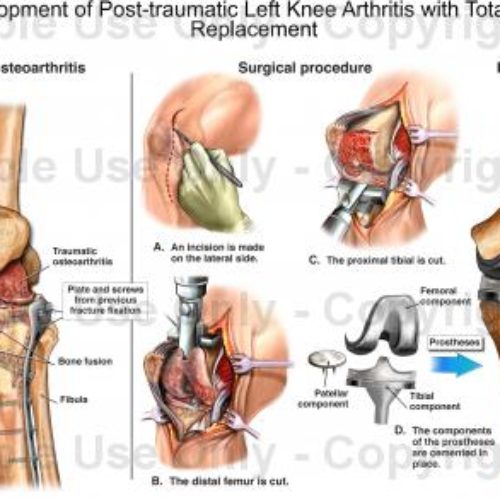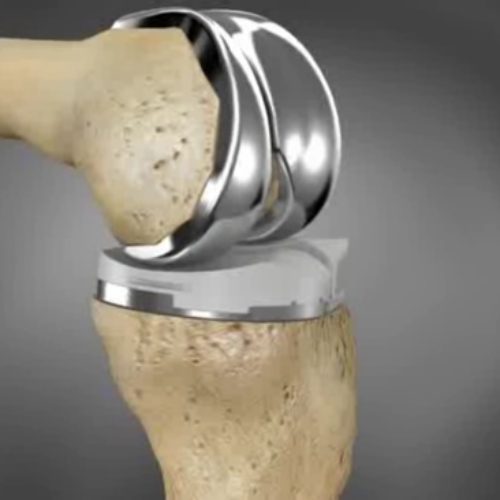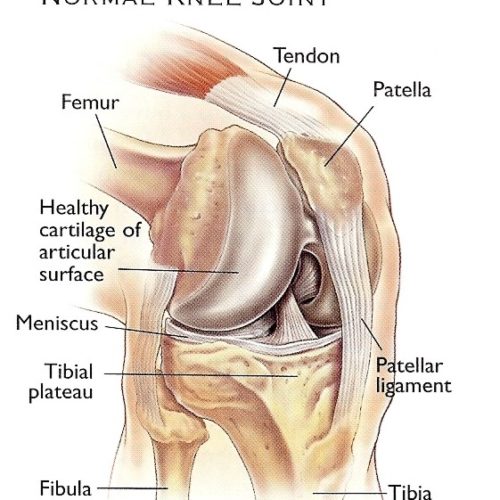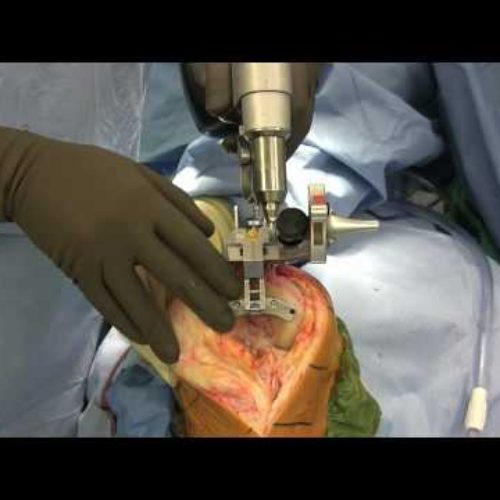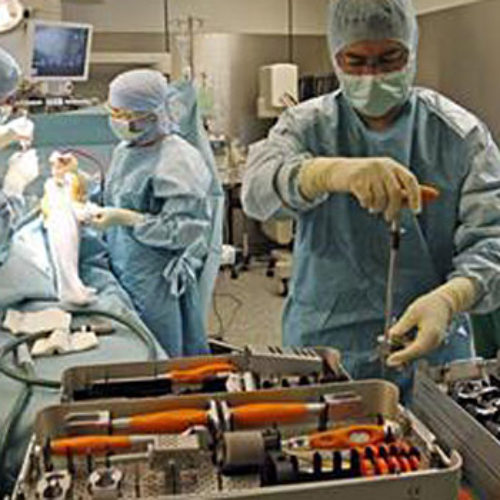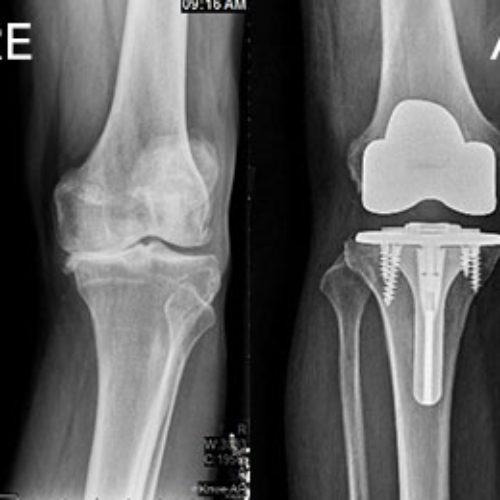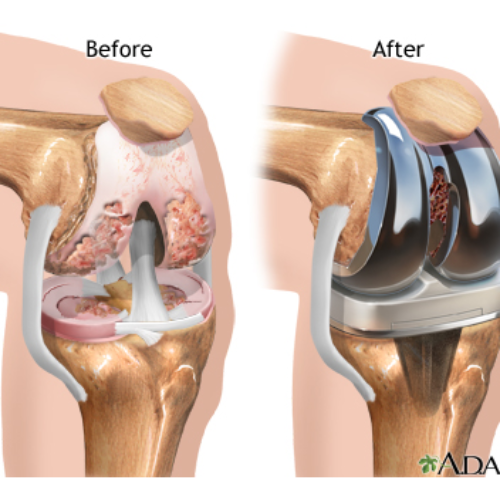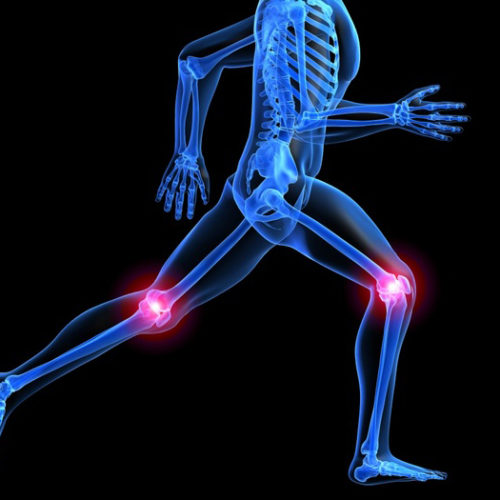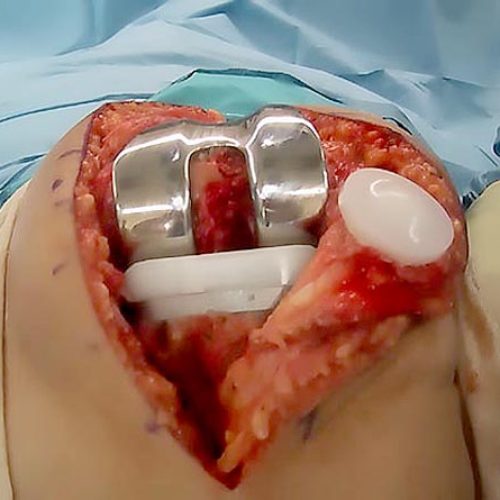Total Knee Replacement
TOTAL KNEE REPLACEMENT (KNEE ARTHROPLASTY)
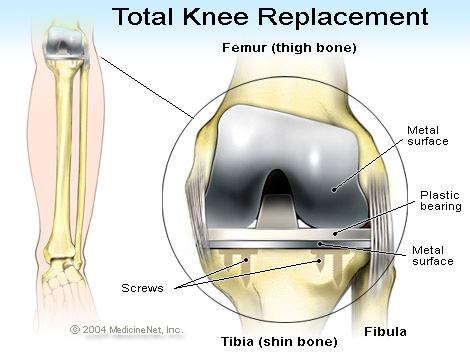
A total knee replacement is a surgical procedure whereby the diseased knee joint is replaced with artificial material. The knee is a hinge joint which provides motion at the point where the thigh meets the lower leg. The thighbone (or femur) abuts the large bone of the lower leg (tibia) at the knee joint. During a total knee replacement, the end of the femur bone is removed and replaced with a metal shell. The end of the lower leg bone (tibia) is also removed and replaced with a channeled plastic piece with a metal stem. Depending on the condition of the kneecap portion of the knee joint, a plastic “button” may also be added under the kneecap surface. The artificial components of a total knee replacement are referred to as the prosthesis.
The posterior cruciate ligament is a tissue that normally stabilizes each side of the knee joint so that the lower leg cannot slide backward in relation to the thighbone. In total knee replacement surgery, this ligament is either retained, sacrificed, or substituted by a polyethylene post. Each of these various designs of total knee replacement has its own particular benefits and risks.
ANATOMY OF KNEE JOINT:
The knee is the largest joint in the body and having healthy knees is required to perform most everyday activities. The knee is made up of the lower end of the thighbone (femur), the upper end of the shinbone (tibia), and the kneecap (patella). The ends of these three bones where they touch are covered with articular cartilage, a smooth substance that protects the bones and enables them to move easily. The menisci are located between the femur and tibia. These C-shaped wedges act as “shock absorbers” that cushion the joint. Large ligaments hold the femur and tibia together and provide stability. The long thigh muscles give the knee strength. All remaining surfaces of the knee are covered by a thin lining called the synovial membrane. This membrane releases a fluid that lubricates the cartilage, reducing friction to nearly zero in a healthy knee. Normally, all of these components work in harmony. But disease or injury can disrupt this harmony, resulting in pain, muscle weakness, and reduced function.
WHO NEEDS TOTAL KNEE REPLACEMENT?
You and your doctor may consider knee replacement surgery if you have a stiff, painful knee that makes it difficult to perform even the simplest of activities, and other treatments are no longer working. This surgery is generally reserved for people over age 50 who have severe osteoarthritis.
Our Services
- Total knee replacement is done with the advanced surgical procedure through best university professors.
- Revised knee arthroplasty is done for patients who have done knee replacement before and now because of any reason needs revised arthroplasty like infection or trauma which is a more complicated case and only few professors do it.
- Treatment of benign and malignant tumors through Total knee Replacement.
- Pre-operative evaluation of patient through advanced diagnostic machines and well experienced medical team.
- Surgery through advanced surgical procedures.
- Post-operative care.
- Handling the possible side effects of surgery.
WHAT HAPPENS DURING KNEE REPLACEMENT SURGERY?
Once you are under general anesthesia (meaning you are temporarily put to sleep) or spinal/epidural anesthesia (numb below the waist), an 8- to 12-inch cut is made in the front of the knee. The damaged part of the joint is removed from the surface of the bones, and the surfaces are then shaped to hold a metal or plastic artificial joint. The artificial joint is attached to the thigh bone, shin and knee cap either with cement or a special material. When fit together, the attached artificial parts form the joint, relying on the surrounding muscles and ligaments for support and function.
WHAT ARE RECENT ADVANCES IN TOTAL KNEE REPLACEMENT?
Minimally invasive surgery has revolutionized knee replacement surgery as well as many fields of medicine. Its key characteristic is that it uses specialized techniques and instruments to enable the surgeon to perform major surgery without a large incision.Minimally invasive knee joint replacement requires a much smaller incision, 3 to 5 inches, versus the standard approach and incision. The smaller, less invasive approaches result in less tissue damage by allowing the surgeon to work between the fibres of the quadriceps muscles instead of requiring an incision through the tendon. It may lead to less pain, decreased recovery time and better motion due to less scar tissue formation.
HOW LONG WILL MY NEW KNEE JOINT LAST?
When joint replacement procedures were first performed in the early 1970s, it was thought that the average artificial joint would last approximately 10 years. We now know that about 85% of the joint implants will last 20 years or more. Improvements in surgical technique and artificial joint materials should make these artificial joints last even longer.
SYMPTOMS WHICH MAKE THE SURGERY NEEDFUL.
- Continued pain instead of using NSAIDS.
- Pain which is not reducing even by using a stick.
- Pain which disturbs the sleep.
- Difficulty in going up and down through stairs.
- Difficulty in rising from a sitting position.
- Inability to perform daily routine activities.
WHAT HAPPENS AFTER KNEE REPLACEMENT SURGERY?
The average hospital stay after knee joint replacement is usually three to five days. The vast majority of people who undergo knee joint replacement surgery have dramatic improvement. This improvement is most notable one month or more after surgery. The pain caused by the damaged joint is relieved when the new gliding surface is constructed during surgery.
After knee joint replacement, people are standing and moving the joint the day after surgery. At first, you may walk with the help of parallel bars, and then a walking device — such as crutches, walker, or cane — will be used until your knee is able to support your full body weight. After about six weeks, most people are walking comfortably with minimal assistance. Once muscle strength is restored with physical therapy, people who have had knee joint replacement surgery can enjoy most activities (except running and jumping).
IS KNEE REPLACEMENT SURGERY SAFE?
Knee joint replacements have been performed for years and surgical techniques are being improved all the time. As with all surgeries, however, there are risks. Since you will not be able to move around much at first, blood clots are a particular concern. Your doctor will give you blood thinners to help prevent this.
Infection and bleeding also are possible, as are the risks associated with using general anesthesia. Other less common concerns that you and your doctor must watch out for include the following:
- Pieces of fat in the bone marrow may become loose, enter the bloodstream and get into the lungs, which can cause very serious breathing.
- Nerves in the knee area may be injured from swelling or pressure and can cause some numbness.
- Other bones may be broken during the surgery, which may require a longer hospital stay.
- The replacement parts may become loose or break.
Persian International Health Tourism is a private company act as a facilitator between patients/visitors, best medical teams and various hospitals suggesting best available options based on your required treatment or other services.

